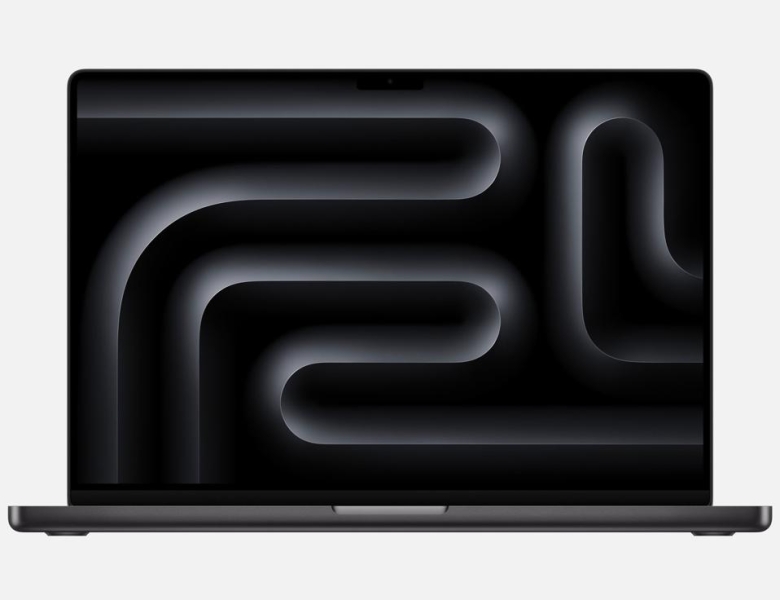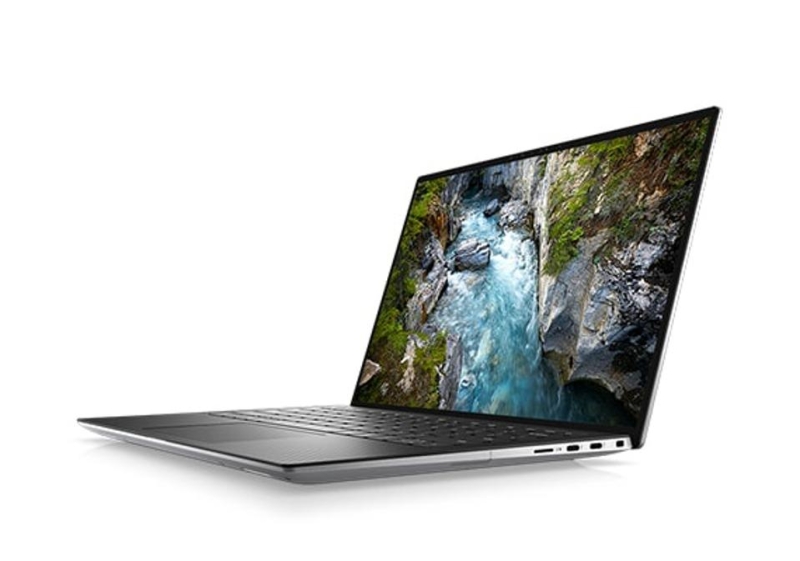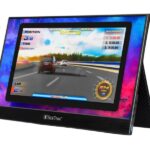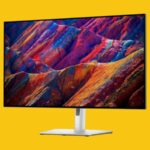
Apple MacBook Pro 16 M3
CPU: Apple M3 Max | RAM: 48GB Unified Memory | Graphics: Apple M3 Max 40-core GPU | Storage: 1TB SSD | Display: 16.2-inch | Resolution: 3,456 x 2,234 | Refresh rate: 120Hz | Battery: Up to 22 hours | Weight: 3.6 pounds
Best for: Apple enthusiasts or those that need a strong battery life.
Pros:
- Incredible battery life
- Top-tier laptop performance from CPU and GPU
- Crisp and bright display
Cons:
- Larger storage sizes are very costly
Apple’s latest generation MacBook Pro 16 comes with a range of CPU options, but the most powerful and capable of the lot is the M3 Max model. It comes with the fastest processor Apple has ever produced, with 16 CPU cores, and an incredible 40 graphics cores, making this laptop powerful enough for any task you throw at it. It can crunch through general computing tasks with ease, and even handle demanding video editing, video transcoding and 3D design. With its 48GB of blazing-fast unified memory and 1TB of snappy SSD storage, it boots up super fast and remains responsive no matter how long you use it for.
It’s not just a powerful work machine though; the Apple MacBook Pro 16 M3 Max is an amazing all-around laptop. Its chassis feels solid, with a sturdy hinge and no give when you pound on the keyboard, and it’s not even that heavy at just 3.6 pounds. Its 16-inch form factor does make it a little less portable than the smaller versions, but this is still a laptop with a near-4K resolution screen at up to 120Hz refresh rate, with super powered components and its battery life is class leading at up to 22 hours. If you want a laptop that can absolutely do it all, the MacBook Pro 16 M3 Max is it.
Best Lightweight Business Laptop
High Performance In A Thin And Light Design

Dell Precision 5480 14
CPU: Intel Core i7-13800H | RAM: 32GB DDR5 | Graphics: Nvidia RTX 2000 8GB| Storage: 512GB SSD | Display: 14-inch | Resolution: 1,920 x 1,200 | Refresh rate: 60Hz | Battery: Up to 15 hours | Weight: 3.3 pounds
Best for: High performance computing on the go.
Pros:
- Lightweight and portable
- Impressive performance
- Extensive battery life
Cons:
- Very expensive
- 1080p display
The Dell Precision 5480’s base configuration is strong, but we particularly like this beefed up version. It combines the powerful 13th-generation Intel Core i7 CPU with 32GB of fast DDR5 memory and the Nvidia RTX 2000 graphics for an impressive array of workstation hardware. Together, they deliver excellent performance, whether you’re browsing the web or rendering UHD video. It also has a 512GB SSD, so it boots up fast and starts applications even faster—though if you’re working with a lot of big files, you might want to augment it with an external hard drive. There are other workstations with this kind of hardware, but few can fit it all into such a compact and lightweight chassis. At 14 inches, the Precision 5470 is small enough to slip into most backpacks, and at just over three pounds, it’s light enough to carry around all day.
The overall design is attractive but understated, and there are a couple of USB-C/Thunderbolt 4 ports for connecting accessories or outputting to external displays using DisplayPort alt mode. If that won’t help with your particular accessories, this laptop comes with a pair of USC-C to USB 3.2 Type A and HDMI adapters to further expand your connectivity options. Its battery life can last up to 15 hours—and it tends to hit that in mixed usage—and in more processor-intensive tasks you can expect it to trend closer to 10 hours.
- With nearly two decades’ experience in tech journalism, Jon also served as the owner of a PC hardware review site. He regularly reviews hardware and accessories, including the best Chromebooks and best gaming keyboards.
- Tech editor Rebecca Isaacs is an expert in consumer tech and constantly tests and reviews the latest products to hit the market, including many on this list.
- Forbes Vetted has published an extensive library of computer guides, including everything from wireless keyboards and mice to business laptops and MacBooks.
- To keep our advice up-to-date, we routinely revise this guide. It was last refreshed in May 2024 to expand our buying advice for business laptops and add the Dell Precision 5480 14 as the best lightweight business laptop.
How We Chose The Best Business Laptops
To find the best business laptops, the Forbes Vetted team combined our first-hand knowledge of a wide range of laptops.
- In addition to asking opinions of fellow tech experts here at Forbes and thoughts of colleagues throughout the industry, we extensively researched and narrowed down the list to HP, Lenovo and more.
- We have had hands-on time with some of these models in person, so well know their build quality and features.
- In addition to our research, we performed extensive comparisons between third-party and user reviews to find the business laptops that everyone says are great; not just the professionals. We also combed through plenty of reviews to make sure that all the laptops here are recommended by real customers, too.
How To Choose The Best Business Laptop For Your Needs
When picking a business laptop, there are a number of important components and features you should consider so that you get the best professional laptop for you.
The processor, or CPU, is the core component in how fast your laptop performs any task, whether that’s simply opening a web browser, or transcoding a video. Most laptops use a model from either AMD or Intel, so make sure your chosen laptop has one from a recent generation—for AMD that’s Ryzen 7000 or 8000, and Intel that’s 13th or 14th generation (also called Core Ultra). My favorite work laptop, the Lenovo ThinkPad Carbon X1 Gen 12, uses the latest generation Intel Core Ultra 155H CPU, with 16 cores and a high clock speed.
Higher number versions are typically faster, and more cores usually mean better performance in more demanding applications. That’s not always the case though, so consider checking individual reviews to confirm the performance of any laptop you may buy.
If you’re buying an Apple MacBook, the latest generation CPU is the M3, with the M3 Pro and M3 Max offering significantly greater performance than the standard M3. The Apple MacBook Pro M3 16 is the fastest of the cohort.
Memory influences performance and how many tasks you can do simultaneously. More memory means you can run more demanding 3D renders, open more browser tabs at once and edit high-resolution video. If you’re just using your laptop for office tasks like word processing and answering emails, you can get away with 8GB, but 16GB is preferable. For more demanding tasks look for at least 32GB; for really demanding video editing or working with huge datasets, get as much memory as you can afford.
Get enough for what you need and a bit more, so that you have room to expand in the future. For simple office tasks, at least 500GB should be absolutely fine, but if you’re working with large files—especially media like video, audio or photos—then 1TB or more is best. Some laptops will let you expand storage with a larger, or additional SSD, but you can also use an external storage drive if you run out of space.
You only need a dedicated graphics chip if you are working with 3D design assets, need CUDA cores to accelerate your application or you want to play games outside of office hours. If you do, look for lots of video memory—10GB plus—for really demanding 3D work. If you aren’t looking for 3D capabilities, get a laptop with onboard graphics (on the CPU), as they are far cheaper and use far less power, so you can enjoy improved battery life.
A great display is beneficial on any laptop, whether you’re working on detailed photo edits or just typing away at a Word document. But there are some displays that are better than others at certain tasks. OLED, like the one in the Dell XPS 13 Plus, offers amazing contrast and clarity, with rich colors and a responsive picture, making them great for HDR movies, photo and video editing and gaming. LCD displays can get brighter, though, so may be better suited to working in harshly-lit offices or outside.
1080p resolution might feel antiquated on your TV, but it’s still perfectly fine for a work laptop. Higher resolutions look more crisp if you’re performing fine digital work, even if they do drain the battery more.
If you want to do any gaming in your downtime, try to get a laptop with a 120Hz or higher refresh rate for a more responsive experience. Alternatively, grab one of the best gaming laptops for true gaming power.
Greater weights tend to correspond with bigger batteries and greater performance, but that’s not always the case (and sometimes, it doesn’t matter, especially if your laptop stays at your desk). There are ultra portable work laptops and desktop-replacement laptops with giant screens and heavier weights. Buy the laptop style and portability that’s important to you, especially if you’re packing it in your bag for a commute.
As a rule of thumb, anything under three pounds is pretty easy to carry around all day, while you don’t want anything over 2.5 pounds if you want to use it one handed as a tablet.
Longer battery life keeps you going for longer away from a charge socket. If you always expect to be working at a desk when power is handy, this isn’t something that’s overly important—especially if fast recharging is also an option. However, if you do like to work away from your desk, or just don’t want to always have to plug your laptop in, longer battery life can be a real treat. The best business laptops for battery life, like the Apple MacBook Pro M3 16, have up to 22 hours of battery life, which is more than enough for multiple work days on a single charge.
Sometimes you’ll be working away from your desk and you’ll drop or bang your laptop. We’ve all been there, but buying a laptop that is extra durable, can really help. Laptops like the Lenovo ThinkPad Carbon X1 Gen 12 are built with extra durable chassis to withstands the rigors of day to day work life, and are even tested to a military grade to ensure they’ll continue working well for you for years to come.
Are Touchscreen Displays Important For Business Laptops?
While touchscreen displays can add versatility to your work setup, their importance depends on your specific needs. They can help with tasks like drawing, note-taking and interacting with certain applications, but they’re not necessary for most business tasks. If touch capabilities and stylus compatibility align with your workflow, it’s a nice bonus, but it’s not essential to your work setup unless you feel you absolutely need one.
Some laptops are 2-in-1s and can flip into “tablet mode,” so you can use them like a tablet. The HP Elite x360 G10 offers a responsive touchscreen and a lightweight design so it works well as a laptop and tablet.
What Storage Capacity Is Suitable For A Business Laptop?
When it comes to storage capacity, opt for 256GB of Solid State Drive (SSD) storage at a bare minimum. SSDs offer much faster performance than traditional Hard Disk Drives (HDDs) and help your laptop boot up quickly and run applications smoothly.
A 512GB SSD provides more space and is better suited for most office workers dealing with documents, applications and files without compromising on speed. If you work with large files or media, consider a higher capacity SSD like 1TB, 2TB or even 4TB. Alternatively, you can buy an external SSD, which can often be cheaper—especially with Apple models like the Apple MacBook Pro M3 16—but the performance won’t be at the same level as an internal drive.
Do Business Laptops Need Dedicated Graphics Cards?
Whether you need a dedicated graphics card largely depends on your line of work. If your tasks involve graphic-intensive activities like video editing, 3D rendering or using CAD software, then a dedicated graphics card is essential. For many business laptops, you’ll find that many mention the Nvidia RTX graphics cards series. So let’s break that down.
While you can find some older laptop models that use RTX 30 series graphics cards, in general, the newest graphics series is the RTX 40 series. Because the 40 series is newer, it comes at a premium price, making the RTX 30 series more appealing. Really, it just depends on your budget and needs. Another option is Apple’s MacBooks. The latest Apple MacBook Pro M3 16 comes with a 40-core GPU which is very, very capable for 3D design work.
However, for typical business tasks such as word processing, presentations and web browsing, integrated graphics cards found in modern processors are sufficient—and can help conserve battery life and reduce costs.


